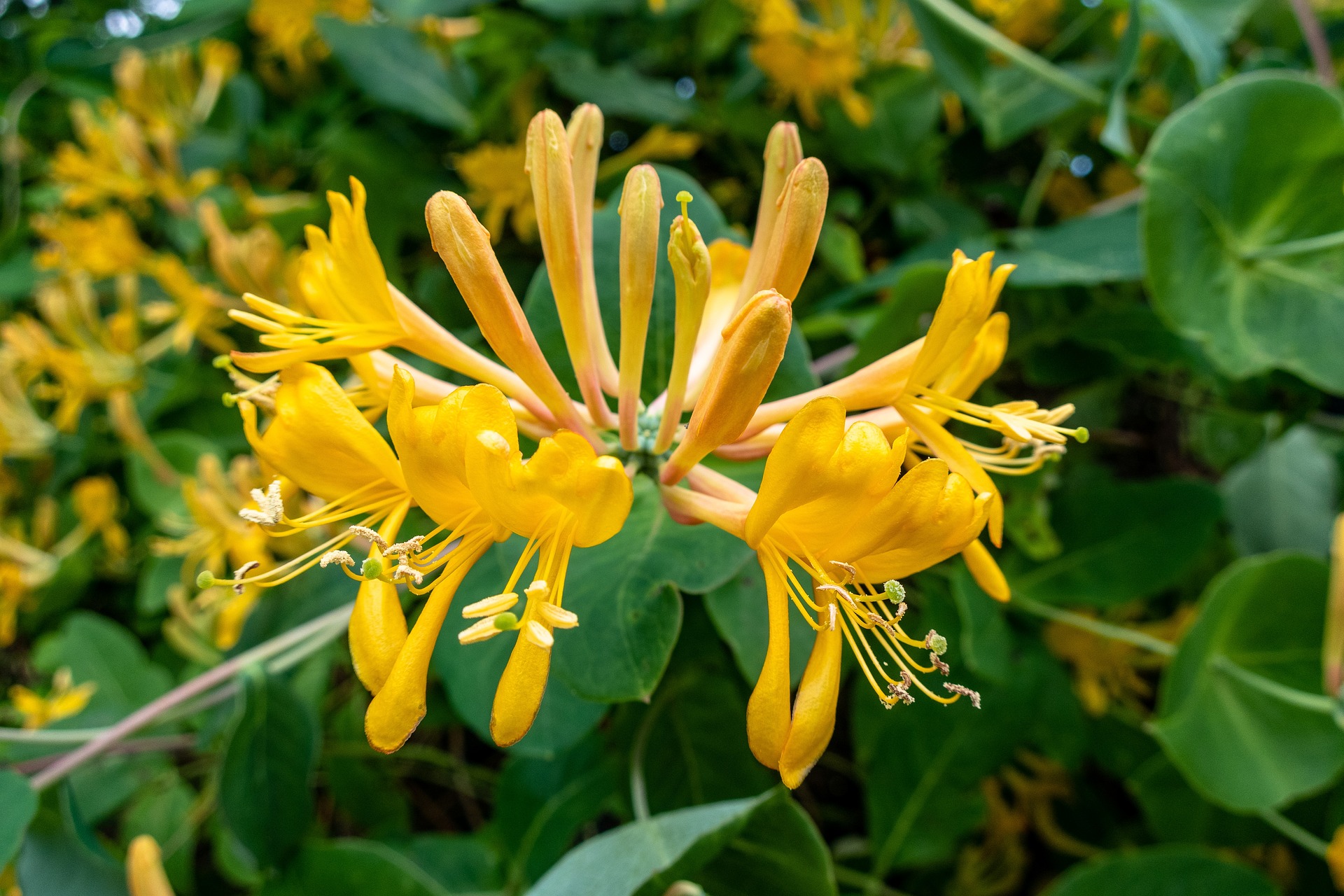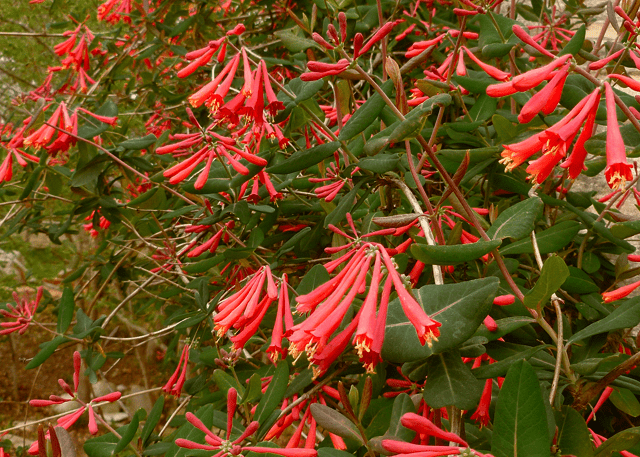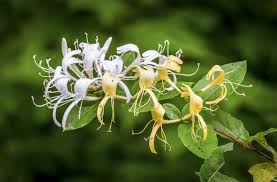Lonicera japonica, commonly known as Japanese honeysuckle, is a fast-growing, deciduous climbing shrub that has captivated gardeners, botanists, and horticulturists around the world. Known for its fragrant flowers and rapid growth, this plant has both positive and negative implications in different ecosystems. While it is beloved for its ornamental qualities, it is also recognized as an invasive species in several regions. In this article, we will explore Lonicera japonica’s characteristics, cultural significance, ecological impact, cultivation methods, and its role in various ecosystems.
Overview of Lonicera japonica

Lonicera japonica belongs to the honeysuckle family (Caprifoliaceae) and is native to East Asia, specifically Japan, Korea, and China. It has a long history of cultivation, both for its aesthetic appeal and its medicinal uses. The plant is known for its rapid growth, which can reach up to 30 feet in length under ideal conditions. Lonicera japonica is a perennial shrub, typically growing in both woody and herbaceous forms, with opposite leaves and tubular flowers that are sweetly scented, often attracting pollinators such as bees, butterflies, and hummingbirds ziatogel.
The plant’s foliage is usually dark green in the summer, turning yellow or reddish in the fall. Its flowers, which bloom from late spring to early summer, begin as white or cream-colored blossoms and later turn yellow as they age. These flowers are not only visually striking but also emit a strong fragrance, especially in the evening, making them popular in garden settings.
Botanical Characteristics
Lonicera japonica is characterized by its smooth, opposite leaves and twining, vining growth habit. Here are the key features that define the plant:
- Leaves: The leaves of Lonicera japonica are oval-shaped with smooth edges and are typically dark green. In the fall, the foliage can turn yellow or red before shedding.
- Flowers: The flowers are tubular, about 1 to 2 inches long, and appear in clusters. Initially white or creamy in color, the flowers later turn yellow. They are highly fragrant, which makes the plant particularly appealing to pollinators like bees, butterflies, and moths.
- Berries: After flowering, Lonicera japonica produces small, dark purple or black berries, which are round and about 1/4 inch in diameter. These berries are toxic to humans and should be avoided, but birds may consume them without ill effect.
- Growth Habit: This plant can grow rapidly and forms a sprawling vine, making it an excellent climber. It often requires support such as trellises, fences, or other structures to help it grow vertically, though it will also spread horizontally if left unchecked.
Cultivation and Care
Lonicera japonica is adaptable and easy to grow, making it a favorite among gardeners. It thrives in a variety of climates but prefers warmer regions. When cultivating this plant, gardeners should consider several important factors to ensure its successful growth:
- Soil Conditions: Lonicera japonica can grow in a range of soil types, from sandy to loamy to clayey, as long as the soil is well-drained. It prefers slightly acidic to neutral soil (pH 6 to 7). The plant is drought-tolerant once established but performs better with regular watering during dry spells.
- Sunlight: This plant thrives in full sun to partial shade. For the best flowering results, it is recommended to plant Lonicera japonica in an area that receives plenty of sunlight during the day, though it can tolerate some shade.
- Pruning: Pruning is essential to control the growth of Lonicera japonica. Left unchecked, it can become invasive, spreading across large areas. Regular pruning helps maintain its shape and prevents it from overtaking other plants. Pruning is typically done in late winter or early spring, before new growth begins. Cutting back old growth encourages fresh blooms and keeps the plant healthy.
- Support: Because it is a vine, Lonicera japonica requires support to climb. Gardeners often train it to grow on fences, arbors, or trellises, which allows it to be used as a beautiful decorative plant in gardens or along walls.
- Propagation: Lonicera japonica can be propagated by cuttings, layering, or seeds. Taking semi-hardwood cuttings in late summer or early autumn is the most common method. For seed propagation, the seeds should be collected in late fall when the berries are ripe. However, it may take a longer time for seeds to germinate and establish.
- Pests and Diseases: Lonicera japonica is relatively resistant to pests and diseases, but it can be affected by aphids, Japanese beetles, and powdery mildew. Invasive pest management may be necessary in regions where it is not native.
Ecological Impact and Invasiveness
While Lonicera japonica has been admired for its ornamental value, it has also become an invasive species in parts of the world, particularly in the United States. In regions like the Southeastern and Eastern United States, Lonicera japonica has spread rapidly in natural habitats, outcompeting native plant species and disrupting local ecosystems. The rapid growth and dense foliage can block sunlight, preventing other plants from thriving and reducing biodiversity.
The invasive nature of Lonicera japonica is primarily attributed to its fast growth rate, ability to spread through both seeds and vegetative means (by rooting at nodes), and its ability to thrive in a wide range of environmental conditions. Once established in an ecosystem, the plant can form dense thickets that smother native plants and even tree seedlings, preventing the regeneration of native forests.
Efforts to control the spread of Japanese honeysuckle have included mechanical removal, herbicide application, and introducing natural predators. However, managing Lonicera japonica remains a challenging task for many conservationists and land managers.
Benefits of Lonicera japonica

Despite its invasive tendencies, Lonicera japonica does have a number of benefits in controlled environments:
- Ornamental Use: In gardens and landscapes, Lonicera japonica can be trained to grow on fences, arbors, and trellises, providing a lush, fragrant cover. Its climbing habit and fragrant flowers make it a popular choice for gardeners looking to add visual interest and scent to their outdoor spaces.
- Pollinator Attraction: The sweet fragrance of the flowers attracts a variety of pollinators, including bees, butterflies, and hummingbirds, making it an excellent addition to pollinator-friendly gardens. Its ability to attract such wildlife helps support the local ecosystem.
- Erosion Control: Due to its fast-growing nature, Lonicera japonica can be used for erosion control on slopes and embankments. Its dense foliage helps stabilize soil and prevent erosion caused by wind or water.
- Traditional Medicine: In traditional East Asian medicine, Lonicera japonica has been used for its medicinal properties. The plant has been valued for its ability to treat conditions such as inflammation, fever, and respiratory infections. Various parts of the plant, including the flowers and leaves, are used to make herbal remedies.
Conclusion
Lonicera japonica, or Japanese honeysuckle, is a plant of contrasting nature. On the one hand, it is loved for its rapid growth, fragrant flowers, and ornamental appeal. On the other hand, it is also recognized as an invasive species in many regions, capable of disrupting native ecosystems and outcompeting local flora. Understanding the balance between the positive aspects of Lonicera japonica and its potential ecological impact is essential for managing this species in gardens and natural habitats.
For gardeners, the key to enjoying Lonicera japonica without contributing to its invasive spread lies in responsible cultivation practices, such as regular pruning and monitoring for signs of unchecked growth. By appreciating its beauty while being mindful of its impact, we can continue to enjoy this fascinating plant while ensuring that it does not overtake the natural landscape.
Also read other interesting articles about Night at the Office: Ulasan Lengkap Game Horor Penuh Ketegangan here

